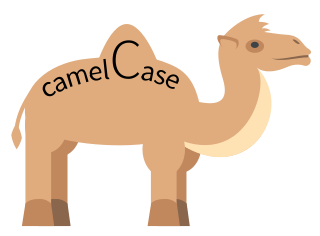
Camel case is the practice of writing phrases without spaces or punctuation, indicating the separation of words with a single capitalized letter, and the first word starting with either case. Common examples include "iPhone", "JavaScript", and "eBay". It is also sometimes used in online usernames such as "johnSmith", and to make multi-word domain names more legible, for example in advertisements.

A database is an organized collection of data, generally stored and accessed electronically from a computer system. Where databases are more complex they are often developed using formal design and modeling techniques.
Eiffel is an object-oriented programming language designed by Bertrand Meyer and Eiffel Software. Meyer conceived the language in 1985 with the goal of increasing the reliability of commercial software development; the first version becoming available in 1986. In 2005, Eiffel became an ISO-standardized language.

Microsoft Access is a database management system (DBMS) from Microsoft that combines the relational Microsoft Jet Database Engine with a graphical user interface and software-development tools. It is a member of the Microsoft Office suite of applications, included in the Professional and higher editions or sold separately. It is also a member of the Microsoft 365 suite. Latest versions have more protections. A trial version of the software is available.
A relational database is a digital database based on the relational model of data, as proposed by E. F. Codd in 1970. A software system used to maintain relational databases is a relational database management system (RDBMS). Many relational database systems have an option of using the SQL for querying and maintaining the database.
SQL is a domain-specific language used in programming and designed for managing data held in a relational database management system (RDBMS), or for stream processing in a relational data stream management system (RDSMS). It is particularly useful in handling structured data, i.e. data incorporating relations among entities and variables.
Hungarian notation is an identifier naming convention in computer programming, in which the name of a variable or function indicates its intention or kind, and in some dialects its type. The original Hungarian Notation uses intention or kind in its naming convention and is sometimes called Apps Hungarian as it became popular in the Microsoft Apps division in the development of Word, Excel and other apps. As the Microsoft Windows division adopted the naming convention, they used the actual data type for naming, and this convention became widely spread through the Windows API; this is sometimes called Systems Hungarian notation.

An object–relational database (ORD), or object–relational database management system (ORDBMS), is a database management system (DBMS) similar to a relational database, but with an object-oriented database model: objects, classes and inheritance are directly supported in database schemas and in the query language. In addition, just as with pure relational systems, it supports extension of the data model with custom data types and methods.
In database systems, isolation determines how transaction integrity is visible to other users and systems. For example, when a user is creating a purchase order and has created the header, but not the purchase order lines, is the header available for other systems or users to see?

Data modeling in software engineering is the process of creating a data model for an information system by applying certain formal techniques.
A query plan is a sequence of steps used to access data in a SQL relational database management system. This is a specific case of the relational model concept of access plans.
A user-defined function (UDF) is a function provided by the user of a program or environment, in a context where the usual assumption is that functions are built into the program or environment.
In computer programming, a naming convention is a set of rules for choosing the character sequence to be used for identifiers which denote variables, types, functions, and other entities in source code and documentation.
The object–relational impedance mismatch is a set of conceptual and technical difficulties that are often encountered when a relational database management system (RDBMS) is being served by an application program written in an object-oriented programming language or style, particularly because objects or class definitions must be mapped to database tables defined by a relational schema.
In computer science, a database cursor is a control structure that enables traversal over the records in a database. Cursors facilitate subsequent processing in conjunction with the traversal, such as retrieval, addition and removal of database records. The database cursor characteristic of traversal makes cursors akin to the programming language concept of iterator.
Borland Database Engine (BDE) is the Windows-based core database engine and connectivity software behind Borland Delphi, C++Builder, IntraBuilder, Paradox for Windows, and Visual dBASE for Windows.
Entity–attribute–value model (EAV) is a data model to encode, in a space-efficient manner, entities where the number of attributes that can be used to describe them is potentially vast, but the number that will actually apply to a given entity is relatively modest. Such entities correspond to the mathematical notion of a sparse matrix.
Semi-structured data is a form of structured data that does not obey the tabular structure of data models associated with relational databases or other forms of data tables, but nonetheless contains tags or other markers to separate semantic elements and enforce hierarchies of records and fields within the data. Therefore, it is also known as self-describing structure.
Apache Empire-db is a Java library that provides a high level object-oriented API for accessing relational database management systems (RDBMS) through JDBC. Apache Empire-db is open source and provided under the Apache License 2.0 from the Apache Software Foundation.
PL/SQL is Oracle Corporation's procedural extension for SQL and the Oracle relational database. PL/SQL is available in Oracle Database, Times Ten in-memory database, and IBM DB 2. Oracle Corporation usually extends PL/SQL functionality with each successive release of the Oracle Database.




